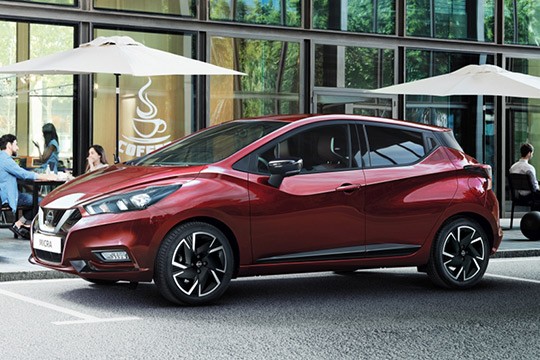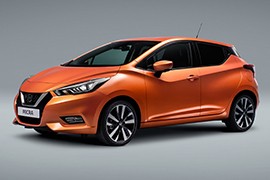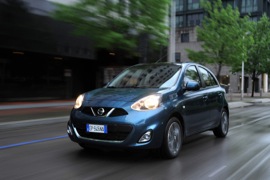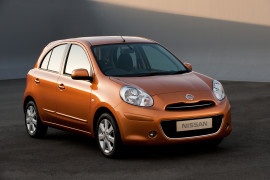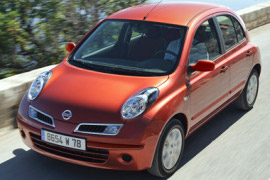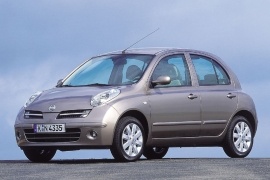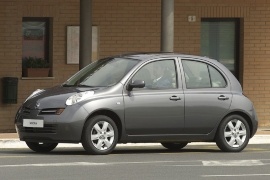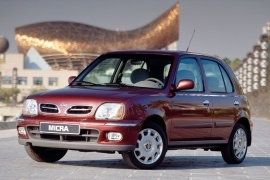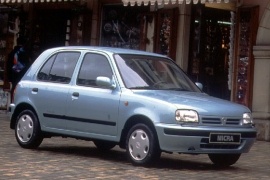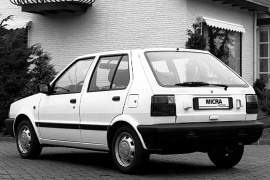NISSAN Micra 5 Doors Models/Series Timeline, Specifications & Photos
First production year: 1989
Engines: , Gasoline, Diesel
Body style: Hatchback
While all the world was fighting with a pandemic situation, the carmakers had to adapt and adjust their lineups to comply with new pollution rules.
Nissan Micra was already in its fifth generation, and it shook the market with its striking look. It was so bold that just a few noticed that it featured rear drum-brakes while other carmakers only had those systems in their museums. But the customers didn't care about that. They cared about look, pollution, comfort, and safety, not necessarily in that order.
From the outside, the 2020 Micra kept the Z-shaped side lines to connect with the famous Nissan Z-vehicles. A new set of headlights was introduced and showed more character, especially when they were upgraded to LED lights. To enhance the side look, Nissan fitted the Micra with wheels up to 17", for the N-Sport trim level.
Inside, the Micra was enhanced with new materials for the upholstery and a wide customization program, including a bold orange interior. On the dashboard, it featured a new infotainment unit that supported Android Auto and Apple Carplay. Like the non-facelifted version, a Bose sound system was available at extra costs.
Renault-Nissan Alliance installed a 1.0-liter turbocharged engine and axed the 1.5-diesel unit used on the 2016 model under the hood.
The fifth generation of the Nissan Micra was unveiled at the 2016 Paris Motor Show. It was built on the same platform as the Renault Clio and it was available only as a 5-door hatchback.
The Micra traced its roots back in time until the '80s. Over time, it was offered in various forms, including sedan, convertible, and a 3-door version. But after the Renault-Nissan alliance started to work on the car, it was considered that the only money-maker would be the 5-door version.
With its sharp angles and floating-roof design, the Micra surprised the world with its look. It was nothing like its predecessor. The grille was crossed by chromed lines and formed a wide shield with a black mesh background. The side Z-line from the front to the rear fenders was a reminder of the Z-series from Nissan.
Inside, the styling was continued in the same edge-design mode. Depending on the trim level, the interior could have been boring or bold. The top-version featured stitched leather on the dashboard and doors, leather upholstery, and a nice infotainment unit surrounded by leather, on the center stack. The instrument cluster was inspired by the 370Z model and it offered, as an option, a head-up display.
The entire engine lineup was from the Renault-Nissan alliance, most of them being built by the French car-maker. There was a choice of 3- and 4-cylinder engines, turbocharged or naturally aspirated, or a turbodiesel. Depending on the powerplant, a 5- or 6-speed manual was on the offer. A CVT also was available.
Nissan introduced the fourth generation of the Micra, also known as the K13 or the March for specific markets, in 2010, and three years later, the automaker refreshed it.
With a long history behind it, the Micra was deemed as one of the most affordable Nissans available but also a trustworthy vehicle that could carry four adults inside and transport them with low running costs. The car was often praised for its qualities but not too much for its look. Nissan tried to change that when it launched the facelifted version of the Micra’s fourth generation in 2013 at the Frankfurt Motor Show in Germany.
Creating supermini vehicles was not exactly one of Nissan’s specialties, but Renault, its alliance partner, was. As a result, the refreshed Micra sported a front fascia that expressed the new design language of the Japanese brand. Since the bio-design era was already gone for almost a decade, the 2013 Micra featured a pair of headlights that combined curved lines with sharp angles on their rear side. Between them, on the main grille, the automaker placed the badge flanked by a V-shaped chromed trim, while on the lower part of the apron, it installed an upside-down trapezoidal air intake flanked by a pair of scoops that could house the fog lamps.
From its profile, the bubble-top styling of the car remained similar to the non-facelifted version of the K13. It sported the same ascending waistline that crossed the car from headlights to taillights. Its body-colored door handles and mirror caps were available across the range, but the B-pillar remained black to create a coupe-like image for the car. To make it look sportier, the automaker added a roof spoiler at the top of the tailgate.
Nissan offered the Micra in three grades, and the lowest one didn’t even have air conditioning. However, that was available as an extra. Still, it came standard on the second and the third trim levels. Space inside was adequate for four people, and even three adults could fit in the back thanks to generous legroom and headroom. Unfortunately, the elbow room was not that good. At the front, the driver fronted a neatly-designed instrument cluster where the speedometer took center stage. Inside its dial, the automaker placed an LCD showing several onboard computer data. On the left, Nissan placed the tachometer, while on the right, a second LCD showed other information, including the trip meter. The sound system was standard across the range, but the navigation was an asset just for the top trim level.
Under the hood, Nissan installed a 1.2-liter gasoline engine paired with either a five-speed manual or a CVT. The powerplant was available in a choice of two power outputs, and strangely, the punchier one was better at the fuel efficiency game than the less potent one.
The fourth generation of the Nissan Micra was unveiled at the 2010 Geneva Motor Show. Its long list of standard features and the decent price made it a good buy for customers around the world.
The first generation of the Nissan Micra was introduced to the market in 1982 and its main quality was its reliability. Over the years, the Micra didn't grow in size. The fourth-generation was, in fact, 5 mm (0.2”) shorter than the first one and that was unusual.
On the outside, the 2010 Micra was designed in the biodesign way, with rounded lines. The front side was designed to mimic a smiling face, with big round headlights, a smile-like lower grille, and a bump in the upper grille that resembled a nose. The round theme was continued to the rest of the vehicle.
Inside, the 2010 Micra offered more interior room than its predecessor. It offered the biggest wheelbase from all the previous generations. Five passengers could sit inside and, due to the arched roofline, the headroom was generous. The trunk was deep and spacious and it could have been extended by folding the rear seats. It was offered with a 60/40 split rear bench.
For the engine compartment, the 2010 Micra was offered with a 1.2-liter gasoline engine, with or without a turbocharger. The standard transmission for both versions was a 5-speed manual, while for the more powerful one a CVT was offered as an option.
Nissan introduced a facelifted version for the Micra range in 2007 and brought more appeal to its small-segment vehicle.
The 2007 facelift was more critical than the one made by Nissan to the K12 Micra in 2005. It even received a new internal code designation as K12C. Usually, when a carmaker made a facelift, it didn't change that. But the Japanese manufacturer made improvements in all the areas, especially in the safety department.
But like any other improved vehicle, the customers should have seen some exterior changes. That included a new grille with a chromed surrounding and fresh, clear turn signals instead of orange. The front bumper featured a narrower grille, leaving some space for the fog lights mounted on the outer side. From its sides, the car revealed its black B-pillars.
Nissan offered the Micra in four trim levels: Visia, Acenta, Tekna, and Active Luxury. That led to new interior trims and upholstery options. While the base levels featured just plain audio systems, the top trim level received Bluetooth connectivity, a 6-CD changer in-dash, and an aux-in 3.5mm jack for external audio sources. It was the era of MP3 portable players. A set of side airbags increased the car's safety with an option for curtain airbags for the rear passengers.
Under the hood, the carmaker installed a 1.2-liter, 65 hp engine only for the Visia trim level. On the other ones, a 1.2-liter, 80 hp was the base powerplant and also benefited for the 1.4-liter unit. The 1.6-liter, 110 hp four-cylinder, which Nissan previously offered only for the three-door bodywork, became available for the Active Luxury trim level.
After three years on the market, the third generation of the Micra needed to be refreshed and prepared for the Euro 5 emission standards, and that affected both the three and the five-door versions.
Facing a tough challenge from other European carmakers, Nissan acted promptly and upgraded the Micra. Yet, it was not that successful, partly due to its uninspired design that made many customers go to other manufacturers. But the Japanese carmaker was not ready to drop the ball.
With a shape that could fit into the bio-design trend, which was already gone, the Micra tried to get those customers who didn't appreciate the new-edge-design direction. Its overall appearance was closer to a bubble than to a sharp knife. The front fascia featured a grille split in two by a slat, and two oval-shaped headlights mounted high enough to be protected from minor scratches. Its profile revealed the same rounded shapes that gave the vehicle a unique styling. In its five-door version, the rear door windows were split into two parts.
Inside, Nissan left the same grey-color interior with a curved dashboard that featured the radio mounted between the center air vents. Its front bucket seats were slim and not very comfortable on long journeys. But since the car was designed and built for the urban environment, it was fine. At least they didn't take too much space, adding some legroom for the rear-seat passengers.
Since the Japanese carmaker was already involved in the Renault-Nissan Alliance, it could take the engines from its French partner. Thus, it didn't have to spend that much to make its engines Euro 5 compliant.
A new design, a new platform jointly developed with Renault, and a new choice of engines made the 2003 Nissan Micra 5-doors a good city vehicle.
The third generation of Nissan Micra was unveiled at the 2002 Paris Motor Show. It was slightly longer than its predecessor but featured a longer wheelbase as well. It was based on the Renault-Nissan alliance B-platform, developed for small and compact-sized vehicles and used by the Tiida/Versa and Renault Megan as well.
The rounded shape of the vehicle was made to attract mostly women customers. Its headlights were mounted high and back, to be protected from parking scratches and minor crashes. Due to its shape, it offered great visibility for the driver. In the back, the oversized bumper was designed with the same purpose: to avoid costly repairs after a minor parking accident. The taillights were installed high and deep enough to be protected in the event of a small incident.
Inside, the Micra was surprisingly spacious and it offered plenty of storage areas in the cabin. It was fitted with front plain seats and a bench for two adults in the rear, or three children. The trunk was limited, but the split-folding rear bench seatback could extend the luggage area up to 584 l (20.62 cu-ft).
For the engine compartment, the Micra was offered with a choice of three gasoline and two diesel engines, mated to a standard 5-speed manual. A 4-speed automatic was available for selected markets and versions.
Nissan decided to introduce a final refresh for the Micra range in late 1999 for the 2000 model year, and besides the exterior upgrades, the drivetrains were also improved.
With the introduction of the Euro 3 emission standards in Europe, which became mandatory for all new cars starting in January 2001, the Japanese carmaker had to improve the Micra after the 1997 facelift.
Even though the biodesign era was closed to an end, the carmaker didn't feel to completely abandoning the ideas. Thus, the two-leaf grille design with chromed surroundings adorned the car's front fascia. Its headlights were slightly curved and featured amber turn-signals incorporated into the headlamps, while the bumper sported, as an option, a pair of reshaped, triangular foglamps that flanked the broad lower grille. From its profile, the small-sized Micra featured body-colored door mirrors, while the door handles were still black. A total of ten colors were available for the car. Last but not least, the carmaker installed light-alloy wheels for the sports trim level.
The interior could have been described as cozy, thanks to the small bucket seats at the front and the narrow bench in the rear. Even though the passengers could climb easier in the back, the elbow- and shoulder room was limited. Moreover, Nissan installed only two headrests on the split-folding (60/40) bench.
Under the hood, the carmaker installed a choice of two engines of 1.0- and 1.3-liter mated to a five-speed manual. For the bigger engine, Nissan also offered an option for a CVT (continuously variable transmission). It was the first time when such a gearbox could have been installed on a vehicle that featured ABS.
Nissan introduced a facelifted version for the Micra in 1998 and improved it in every way, starting with the exterior look and ending with the powertrains.
Nissan saw an opportunity in small vehicles when it introduced the Micra and tried to keep its advantage over the years. But Renault, Peugeot-Citroen, Fiat, Opel, and Volkswagen were there to get a slice of the market. But Nissan was no new nor inexperienced carmaker in that segment and proved it when it refreshed the Micra.
From the outside, the 1998 Micra looked very similar to the non-facelifted version. It featured a new front fascia with a pair of leaves-looking grille separated by a vertical slat that supported the brand's logo. The rear doors sported were narrow, but thanks to their wide opening system allowed an adequate ingress and egress to the car. Thanks to its rounded corners and softer edges, the Micra 5-Doors managed to fit into the bio-design trend.
Inside, Nissan made a few changes, especially for material quality. The rounded shape of the dashboard and the oval-shaped instrument cluster was considered chic and trendy. In the back, its single-piece folding seatback increased the trunk area.
Under the skin, the 1998 Micra was drastically improved. Along with its refreshed gasoline engines, Nissan also installed a diesel engine bought from Peugeot. The Japanese carmaker offered a CVT gearbox, which was available for selected engine versions.
The first Nissan Micra was introduced in 1982 in Japan as Nissan’s response to the successful Honda City.
It was later in 1983 when the small Micra came to Europe and impressed everyone with its practicality and the low fuel consumption.
While the first generation offered a single engine option, the second generation released in 1992 came with two new aluminum units with capacities of 1.0-liter and 1.3-liters. The powerplants developed 65 hp and 74 hp respectively. A diesel version was also available with the 1.5-liter PSA TUD engine.
Besides the 5-door version, Nissan also offered the Micro with a 5-door body style.
The small Micra could be equipped with more safety features that were not common for a car in this class: a safety-cage, side-impact door beams, pre-tensioning seatbelts and a driver’s airbag. Although equipped with the mentioned equipment, the Micra didn’t score well at the Euro NCAP testing, receiving only 2 stars.
Depending on the market, the Micra came with standard or optional airbags, anti-lock brakes, electric windows, power steering, central locking and air-conditioning.
The Nissan Micra was the first Japanese car to win the European Car of the Year in 1993.
While the supermini didn’t have the most stylish exterior design, it proved to be a reliable and easy to maintain vehicle, perfect for city traffic.
Nissan introduced a final facelift for the Micra's first generation in 1989, trying to keep the car on the market until a new model was ready to face the market.
Micra has had serious difficulties hiding its age since it was launched in 1982. Despite a few other upgrades, its design was dusty, and the wedged shapes of the early-'80s were no longer something to look for. Moreover, the newer vehicles fitted with fuel-injected systems started to show their fuel efficiency in front of older, carburated systems.
In terms of design, it was challenging to hide the boxy shape of the Micra. To fight this, Nissan shaved the edges and the corners of the car and made it look rounder. Yet, the front fascia sported the same rectangular headlights that flanked the black slatted grille above the unpainted bumper that incorporated the blinkers. The profile revealed unpainted door handles and mirrors, while at the back, the squared taillights flanked the tailgate. In the five-door version, Micra's designers managed to create fully opening windows.
Despite having five doors, the cabin didn't provide too much comfort for the rear passengers. At the front, Nissan installed bucket seats, while at the back, it mounted a folding bench. The latter also could fold down to expand the otherwise small trunk space. In terms of equipment, it was scarce, with cranked windows and fabric on the seats. Moreover, even the stereo was on the options list.
Under the hood, Nissan offered the Micra with a choice of two engines, both gasoline and paired with a five-speed manual.
